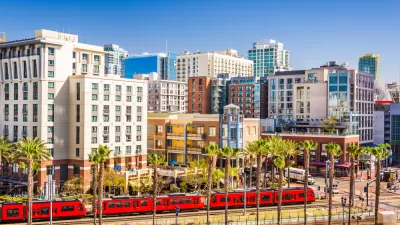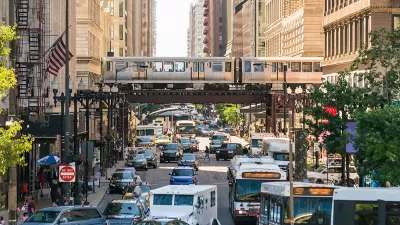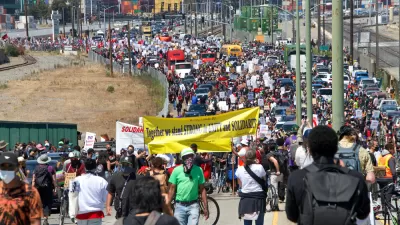The American Planning Association gathers for its first in-person National Planning Conference since 2019. Planetizen is in attendance, and here is some of what we saw on the first day of the conference.

It’s the first in-person National Planning Conference (NPC) since San Francisco in 2019, and although last year’s online conference started the discussion about social equity and the need for the field of planning to “right past wrongs” from the very first words spoken by American Planning Association (APA) CEO Joel Albizo and President Leo Asuncion, everything is hitting a little different with other people in the room.
I spent most of the day trying to check the vibe of the event, hoping to gain insight into how the profession has evolved in two of the most tumultuous years in living memory—the consequences of the pandemic for the ideas and practices that build the very foundations of the profession that unites all gathered here in San Diego this weekend. Here are a few notes on what I found.
APA Leadership Sets the Stage
As per tradition, APA leadership, once again Albizo and Asuncion, welcomed the audience. The gap in NPC gatherings was quickly noted. The pandemic "made things interesting,” said Asuncion, but "we [planners] never stopped being a community." The theme of community was reiterated in several forms: the two took crowdsourced questions from the room. Asuncion reminded everyone of their role in helping communities adapt to a changing world and noted the unique “people focus” of the planning profession as compared to its allied professions in the built environment.
Echoing the contrition of last year’s event, the two repeated an admission of the planning community’s role in the historic exclusion of communities. "Planning had a role in all of the issues surrounding BIPOC communities,” said Asuncion. “Yes, planning was a part of it."
Albizo offered that this weekend’s conference is the beginning of "the long-awaited road to a new and hopefully better future." As I would find out throughout the day, however, planners are still figuring out the details of the journey, and still struggling to get unstuck from some of the mire of the past two years. I don’t offer this observation as a critique. In fact, the ongoing struggle—the search for answers—made the day’s events surprisingly compelling.
‘Stop Dancing and Start Listening’
The morning keynote was a blast. I already discussed some of the inspiration and fun offered by Michael Ford’s keynote in a short post from earlier this morning—suffice to say that the message of the presentation is sticking with me, and is likely to do so for a long time. If you don’t already know, Michael Ford is the founder of the Hip Hop Architecture Camp and has succeeded in bringing the intersection of music and design—hip hop and design—to the attention of the mainstream. It’s likely, however, that the mainstream—thanks to coverage for the camp on ESPN, NPR, Oprah, the Today show, and more—is more aware of the growing hip hop architecture movement than your run of the mill planner.
Ford, who is als a leading voice about the need for the planning and design communities to reckon with their role in the ongoing violence against Black communities in the United States, delivered one line that I heard several planners reference throughout the rest of the day at the conference. Planners are always talking about the need to hear from underrepresented communities for equity. “You have heard from them,” said Ford, because hip hop offers a critique of the effects of cities and society on the Black community. Americans, and planners, spend so much time dancing to hip hop without really listening to the critique.
“We need people to stop dancing and start listening,” said Ford. It wasn’t the final word of the presentation, but it was the final word on an era.
Pandemic Planning
One of my only disappointments of the day was only finding one 15-minute session that directly how the pandemic has changed the practice of planning. I’m talking about everything but online public meetings (there were several public engagement sessions, including one on virtual public meetings that closed the doors shortly after it started so I didn’t get to check it out): eviction relief, homelessness interventions, open streets, al fresco streets, shifting commutes. The possibilities could fill a four-day conference.
The one session I did find on the challenges of planning during the pandemic was excellent but all too brief at 15 minutes. George J. Proakis, executive director of the Mayor's Office of Strategic Planning and Community Development for the city of Somerville, Massachusetts, talked about some of the opportunities to plan a different way during the pandemic. Of particular note: Somerville’s success, after years of Proakis wishing it were possible, to shut down a slip lane to car traffic, filling it instead with outdoor dining tables. Regarding the Somerville Shared Streets program, Proakis said something that would be another theme to emerge from the day: planners are still trying to figure it out. The city recently made changes to make outdoor dining areas more universally accessible, for example. Another big question presented by the program, according to Proakis, is what it means for the city’s parking requirements.
Zoning Reform Exceeds Capacity
I tried to attend two conference sessions on zoning reform. The first one, hosted by Jason L. Jordan, APA public affairs director, included YIMBY rockstar and former mayor of Culver City, Alex Fisch. The wall-to-wall standing room-only capacity of the room was too much for my post-pandemic nerves when I arrived there three minutes after the session started. From what I saw on Twitter, the room was full beyond capacity several minutes before the session started. I think this is maybe a sign of latent demand in the profession for zoning reform. Has the housing affordability crisis finally hit a tipping point where planners all over the country are finally getting behind the cause, following the example of the avant-garde of Minneapolis, Oregon, California, and, just last week, Maine?
I did manage to attend a working session where attendees gathered around tables to discuss the challenges and opportunities of zoning reform. The room was clearly behind the cause, but nobody knows better than planners the many obstacles to achieving the desired effects of zoning reform—most namely cultural resistance from a nation of aspiring single-family detached home owners and market considerations like what developers are willing to build and bankers are willing to finance.
Zoning reform is obviously still a work in progress, like so many of the other themes of the day. Maybe next time zoning reform sessions should take place in the biggest room at the conference.
A Fundamental Shift in Planning
My day’s concluding sessions focused on California’s efforts to completely shift its approach to planning. You might have missed the news on July 1, 2020, but the entire state recently completed a state-mandated transition from using Level of Service (LOS) as its metric for measuring development impact to Vehicle Miles Traveled (VMT).
The first session, “GHG Reduction Through TOD: Why It's (Almost) Illegal,” laid out the difficulties of transit oriented development (TOD) was a sobering reminder about the pitfalls in a legal system built around environmental laws that make it very hard to meet environmental goals (namely, the California Environmental Quality Act (CEQA). The first speaker of the panel, author Christof Spieler, made the case for TOD more effectively than I’ve ever seen. One message I took from Spieler is that the world would be better served if more people actually took transit, which depends entirely on high quality transit being built. "If you ride transit you know these things,” said Spieler.
The next session, “A VMT Mitigation Survival Guide - Banks/Exchanges/Fee Programs,” was even more of a wakeup call for me, a transit rider. While acknowledging the need to shift from LOS to VMT ("VMT really measures accessibility,” said panelist Katy Cole), the session was a classic study in the difficulties of achieving meaningful change through planning innovation alone. Many feasible, desirable developments are having trouble achieving thee VMT mitigations that guarantee entitlement, according to panelists. Jurisdictions in the state of California are exploring opportunities for new forms of mitigation, such as banks, exchanges, and fee programs. The idea is to make VMT mitigation work like habitat mitigation. Again, planners are still figuring out how to make it all work.
One key concept that I learned during the session was something called “additionality.” As defined by CEQA, additionality means VMT mitigations can only count they are directly caused by the project.
But the biggest challenge of all has to do with equity. When it comes to both TOD and VMT reductions, the biggest achievements of mitigation sometimes run counter to considerations of equity. As detailed in a study published by Transfers Magazine in Spring 2021, differences in demographics mean that the most equitable mitigations don’t achieve as much trip reduction as less equitable mitigations. In the example used in the session, a study from UCLA found that six students need a free transit pass to mitigate one VMT—most of which would be achieved by one student.
So, two of the big crises facing planners—climate change and equity—are in direct conflict. With a moral imperative to improve on both, the planning field has a lot of work to do. No example I encountered all day captures the challenge and opportunity of planning in 2022 than this conflict. God speed, planners.
Notes on the Host: San Diego
NPC22 host city San Diego boasted perfect spring weather on Saturday. So far, Sunday is showing visitors a dose of what we coastal Californian’s call “May Grey” (i.e., the slightly older sibling of “June Gloom”). Attendees who haven’t yet should walk past the main ballroom and step outside onto an outdoor terrace, where they’ll be greeted with stunning views out across the San Diego Bay. The massive and graceful arch of the Coronado Bridge looks close enough to touch but far enough away to look like it climbs a mile high. The skyline is surprisingly cosmopolitan—and the cranes and construction projects dotting downtown suggest there is more to come.
San Diego Mayor Todd Gloria, who was the first person to step on stage at the conference, seemed aware at San Diego’s underdog status. "We too often act like a small town and not the eighth largest city in the country,” said the mayor. But the city is obviously punching above its weight when it comes to planning innovation. The mayor touted the city’s density bonus program, which, as noted by Planetizen in April, has produced hundreds of affordable units since its inception in 2016. Mayor Gloria also mentioned the equity vision set forth in the city’s parks master plan, the Build Better SD plan for public buildings and infrastructure, the San Diego Association of Governments’ (SANDAG) 2021 Regional Transportation Plan, and the city’s implementation of the statewide upzoning law, SB 9 (the city is one of only a few California cities to be rated as an “A” on SB 9 implementation from co-development platform Homestead). "I hope you see a city embracing its size," Gloria told the audience. I think that is what we are seeing.
Gloria also offered one more validation for the audience, saying that although he wouldn’t trade being a big city mayor, if he could do it again, he would have been a planner.
I hope Mayor Gloria would be ready to get to work.

Trump Administration Could Effectively End Housing Voucher Program
Federal officials are eyeing major cuts to the Section 8 program that helps millions of low-income households pay rent.

Planetizen Federal Action Tracker
A weekly monitor of how Trump’s orders and actions are impacting planners and planning in America.

The 120 Year Old Tiny Home Villages That Sheltered San Francisco’s Earthquake Refugees
More than a century ago, San Francisco mobilized to house thousands of residents displaced by the 1906 earthquake. Could their strategy offer a model for the present?

Alabama School Forestry Initiative Brings Trees to Schoolyards
Trees can improve physical and mental health for students and commnity members.

NYC Outdoor Dining Could Get a Re-Do
The city council is considering making the al fresco dining program year-round to address cost concerns from small businesses.

HSR Reaches Key Settlement in Northern California City
The state’s high-speed rail authority reached an agreement with Millbrae, a key city on the train’s proposed route to San Francisco.
Urban Design for Planners 1: Software Tools
This six-course series explores essential urban design concepts using open source software and equips planners with the tools they need to participate fully in the urban design process.
Planning for Universal Design
Learn the tools for implementing Universal Design in planning regulations.
Ada County Highway District
Clanton & Associates, Inc.
Jessamine County Fiscal Court
Institute for Housing and Urban Development Studies (IHS)
City of Grandview
Harvard GSD Executive Education
Toledo-Lucas County Plan Commissions
Salt Lake City
NYU Wagner Graduate School of Public Service






























